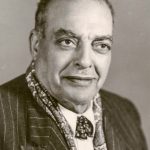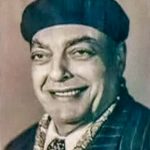Amar Foundation presents: Min Al-Tarikh
Mustafa Said: Welcome, dear friends, to a new episode of Min Al-Tarikh as we continue our talk with the great musicologist his highness Frederique Lagrange Pasha about Sheikh Zakariyya Ahmed. We remain with the Trio Bayram, Zakariyya and Thouma in one of the songs to which I heard more than 20 recordings.
Frederique Lagrange: And the Good-bye. Many other songs like Ana Fi’ntizarak deserves a long stop, and also Habeebi Yes’id Aw’atoh also deserves a long stop, yet I want to hear your opinion about the end, i.e., the end of the collaboration between Bayram, Zakariyya and Om-Kolthoum in Huwwa Saheeh El-Hawa Ghallab.
M: Yes, the farewell after a long pause, or as it was said I El-Awwila Fel-Gharam “We-kan wisaloh wada’uh, mi baad tool imtina’uh” i.e., “His talking after his long pause was his farewell”. This is what happened.
F: Exactly.
M: Huwwa Saheeh was the reconciliation and the farewell after a long boycott. A very beautiful tune.
F: This song was sung in 1960. The gradual reconciliation between Sheikh Zakariyya and Om-Kolthoum may have begun in 1959.
M: Probably even before this, since the legal procedures between them ended.
F: It’s a possibility, but it wasn’t easy to take the decision to work together again in a project. Certainly, it was not possible for Sheikh Zakariyya to present a tune to Om-Kolthoum the required the same effort like El-Awwila Fel-Gharam as her vocal capabilities in 1959 were not as before, especially, I think, that Om-Kolthoum’s voice changed around 1957-8. With the increase of her illness, her voice became lower in pitch: similar in strength, yet sometimes it tended to be a bet harsher. Riad El-Sonbati couldn’t deal with this change in the 1950’s whereas Sheikh Zakariyya took it into consideration, and he made a tune suitable for the decrease of Om-Kolthoum’s vocal area, and yet, he left a very big space for her to show off and deal with the song. By the way, she didn’t improvise in all of Sheikh Zakariya’s songs. As far as I can remember, in El-Aahat for instance, she didn’t improvise as much. Let’s get back to Huwwa Saheeh El-Hawa Ghallab. It’s known that in Huwwa Saheeh El-Hawa Ghallab, she improvises in the final part. Remind me: [Mustafa sings from under his breath], “Ya albi aah, el-hobb warah ashgan we-alam, wa’ndam we-atoub, we’ala’l-maktoub mayfidsh nadam”.
M: Look, what you described as “harshness” in her voice appeared even in the lyrics here.
F: correct, it has cruelty. The harshness which appeared in the very voice of Om-Kolthoum was reflected in a number of lyrics, not only by Bayram, but by other lyricists as well.
[Listen to part of the above-mentioned improvisation.”.F: I’d like to focus on three recordings for Huwwa Saheeh: the second performance for this song in February 1961. In this second performance, she decided to improvise in the second verse “Nazra wekont ahsibha salam”. She decided to make a rhythmic improvisation on the nasal sound [n] of “Nazra” [he sings it].
[Listen to this improvisation.]F: Then she returned to making the usual improvisation in the last verse.
[Listen to improvisation in the last verse.]F: In 1965, the idea of improvising on “Nazra we-kont ahsibha salam” returned. There’s a concert in 1965 in which she returned to this improvisation and develop it.
[Listen to this improvisation from the 1965 concert.]F: The third time, she became old. She became an old lady. We are talking about one of the concerts for military missions, i.e., 1968, Morocco. I may take it for granted that the concert of Huwwa Saheeh El-Hawa Ghallab in Morocco in 1978, though Om-Kolthoum’s voice wasn’t that of 1961 and though 7 years which influenced her voice and her morals after the 1967 relapse had passed, was, I can openly say despite all this, the last appearance on stage for Om-Kolthoum. Of course it’s well-known that her last concert was in January 1973, yet, I’m talking here about the true Om-Kolthoum, the legendary being, the teacher. The last time the Teacher Om-Kolthoum appeared duly on stage was in Rabat, Morocco in 1968. When she returned to this song in this concert, she substituted the vocal area with imagination. She thought about improvisations which she would never have thought about in 1961 so much so that she modulated to Segah. She improvised in Segah in that part.
M: She did really substitute the vocal area with her imagination. It’s true that her imagination is the characteristic and the advantage of this recording. One cannot understand how she thought about the Segah here. One cannot also understand how she turned around the high Muhayyer and sang it an octave lower.
F: Indeed, she was completely aware of her technical capabilities, and she knew that in 1968, her voice was no longer the voice of the 1950’s. She was aware. She knew herself, she knew where to she could reach, and so, she could sing the song in a way that reminds one of Bayram and Sheikh Zakariyya in the 1940’s and beginning of the 50’s.
M: this is even though the Takht in the middle of her ensemble started to lose some of its members.
F: Yes of course. In the 1960’s we’d never have heard that the Takht would turn into a Mawlid ensemble as in the recording of 1952. They couldn’t do that.
M: yes, they were not the same people.
F: And yet, in Huwwa Saheeh in Morocco in 1968, one can still hear classical Arab music though we’re in the 1960’s. I may surprise you when I say that Om-Kolthoum’s ghost reappeared once more in April 1972. I see that you’re reaching for your slippers and that I’ll be beaten now! But the part in which she improvised in Ya Msahharni “Ya msahhar el-nom fi inayya, sahhart afkari wayyak”, she repeated it for three times in different colours. She may have thought about an improvisation. But, to repeat it three times in different colours in the first time of the song, though she sang it in a mediocre way later, but, in its premier, let’s say that half of Om-Kolthoum, the ghost of Om-Kolthoum, or something of the real Om-Kolthoum appeared on stage.
M: Talking with you is never boring. It’s always useful, beautiful and with a lot of music and Tarab we Gameel Maloosh maseel as in Dawr Khadni El-Hawa. Let’s now listen to the last real appearance of Om-Kolthoum, the disciple of Sheikh Abul-Ila, Sheikh Zakariyya, and Sheikh Ibrahim El-Beltagi. Let’s listen to the last recording of Huwwa Saheeh in Rabat in King Mohammed V Hall. This tune was so loved by herself and by her audience so much so that King Al-Hassan asked her personally to sing it during her tour in Morocco. Listen to Huwwa Saheeh El-Hawa Ghallab, Maarafsh Ana, Bayram, Zakariyya and Om-Kolthoum in king Mohammed V hall, Rabat, in April 1968. Until we meet again in another episode of Min-Al-Tarikh, we leave you with Om-Kolthoum, her ensemble, Bayram and Zakariyya in peace.
[Listen to Huwwa Saheeh El-Hawa Ghallab, full recording.].The end.
- 221 – Zakariyya Ahmed – 12 (1/9/2022)
- 220 – Zakariyya Ahmed – 11 (1/9/2022)
- 219 – Zakariyya Ahmed – 10 (11/25/2021)
- 218 – Zakariyya Ahmed – 9 (10/26/2021)
- 217 – Zakariyya Ahmed – 8 (9/24/2021)
- 216 – Zakariyya Ahmed – 7 (9/4/2021)
- 215 – Zakariyya Ahmed – 6 (8/28/2021)
- 214 – Zakariyya Ahmed – 5 (8/6/2021)
- 213 – Zakariyya Ahmed – 4 (6/26/2021)
- 212 – Zakariyya Ahmed – 3 (5/27/2021)
- 211 – Zakariyya Ahmed – 2 (5/1/2021)
- 210 – Zakariyya Ahmed – 1 (4/28/2021)
- 209 – W-al-Lāhi lā astaṭī‘u ṣaddak 2 (4/6/2017)
- 208 – W-al-Lāhi lā astaṭī‘u ṣaddak 1 (3/30/2017)
- 207 – Bashraf qarah baṭāq 7 (3/23/2017)


